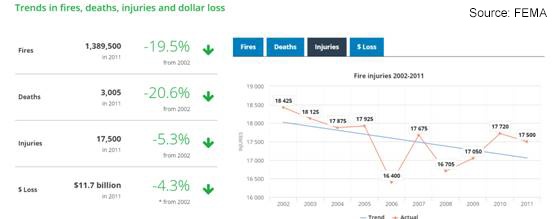In the past, this blog has asked rhetorically “Why do insurers ignore wildfire?” It’s a peril that causes real losses (about $6B in the past 20 years in the USA alone), yet has data and analytics that can significantly improve residential and commercial underwriting for it. The readership metrics for Risks of Hazard reinforces the question: blogs about wildfire get opened less than any other subject we write about. Today, let’s answer that rhetorical question: Here is why insurers pay less attention to wildfire than they should.
Every summer, wildfire is high profile. The names of some recent fires are evocative: Rim, Sleepy Hollow, Waldo Canyon. This year the headlines are coming from the East: Pennsylvania has the Lehigh Valley Fire, and the late April NFS situation report lists fires in six eastern states. In Canada, the news is harrowing as Fort McMurray (pop. 80,000) is being evacuated as the city burns. Notoriety and media coverage is not the problem.
FEMA publishes statistics that might explain why the peril does not get the attention it deserves:

These statistics convey two messages that belittle wildfire:
- The overall losses from wildfire are a tiny portion of overall fire losses. Comparing 2011 overall fire losses ($11.7B) to an average wildfire year ($0.3B), the puny size of the wildfire doesn’t attract attention.
- The trends for all metrics are descending due to advances in fire suppression and construction.
Granted these stats contribute to wildfire’s neglect, why should insurers pay more attention to this peril?
The obvious reason to pay more attention is that it is so well modeled and well-suited to underwriting.
A more subtle reason is that the stats above are limited due to certain reporting issues:
- Catastrophic losses, such as wildfire, only get counted as such once there is $25M of aggregated damage affecting a decent swath of insurers. Meanwhile, many wildfires don’t break that threshold and thus don’t get captured as cat losses.
- The information that is compiled by FEMA specific to wildfire is typically centered on timber: acres burned and numbers of fires. They don’t compile structure damage, leaving the insurance industry as the main source of structural losses and that compiled information is incomplete.
With these imperfections in the reporting, the true scope and trend of wildfire damage is missing.
Not only are the historical figures skewed – the potential future damage is skewed. According to the Insurance Information Institute (I.I.I.):
A 2015 study by CoreLogic identifies almost 900,000 residential properties across 13 states in the western U.S. currently at high or very high risk of wildfire damage. They represent a combined total property value estimated at more than $237 billion. Of the total properties identified, 192,000 homes fall into the very high risk category, with total residential exposure valued at more than $49 billion.
These figures are based only on the 13 western states, and the model used doesn’t fully grasp the potential of wind-blown embers (embers are handled in the CoreLogic model by adjusting a score upwards for properties near a High Risk zone, with no accounting for the likely generation of embers or their travel path). Thus, the estimates published by I.I.I. are likely low.
Considering the limitations of the published data and potential loss information, and the realities of wildfire those limitations shroud, property insurers should be addressing wildfire in their underwriting. It is a peril that is needlessly, and unwisely, neglected. Dependable models and analytics are available now to handle it.

